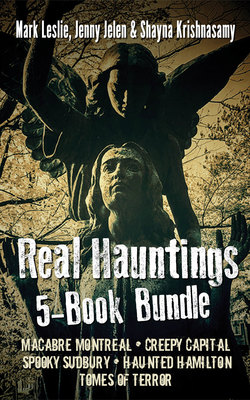Читать книгу Real Hauntings 5-Book Bundle - Mark Leslie - Страница 40
На сайте Литреса книга снята с продажи.
The Knotty Poltergeist The McGill Ghetto, Plateau-Mont-Royal
ОглавлениеYou may have already smiled at what you think may be a “naughty” typo in the title of this chapter. Or perhaps you enjoyed the cheeky play on words because you are already familiar with the paranormal mystery that has, for almost one hundred years, plagued a home on Prince Arthur Street between Sainte-Famille Street and Parc Avenue.
This particular mystery, believed to be a poltergeist, doesn’t involve the usual “noisy spirit” phenomenon — loud noises, knocking over of furniture, or the levitation or throwing of objects by unseen hands. Instead, it involves the appearance of unexplained knots. The phenomenon began in 1929, as outlined in Pat Hancock’s 2003 book Haunted Canada: True Ghost Stories, with knots that appeared in curtains, towels, sheets, pillowcases, articles of clothing, and various other fabrics throughout the home.
The family was unable to explain the bizarre occurrences, and were soon frustrated with the fact that virtually anything in the home that could be twisted into a knot was tied into ones that were small and tight. Convinced that one of the children was tying the knots, the parents kept a close eye on them. They were, however, unable to find anything amiss in their kids’ behaviour. At a loss for a reasonable explanation, they then turned their suspicions upon one another.
But still, no human culprit could be detected.
At their wit’s end, they eventually contacted a local journalist as well as a local church, wondering if the home needed to be blessed in order to rid it of the mischievous spirit or spirits at work. Nearby St. Patrick’s Church sent two priests to the home. They performed an exorcism ritual in an attempt to dispel the spirit or spirits from the building. But the attempted exorcism of the ghost was fruitless. One of the family members allegedly informed a local journalist that they were told that somebody must have cast a spell on the home.
Finally, not sure what to do next, the family reached out to the local police. When the officers arrived at the family’s home, police did a quick search of the house and then interviewed each member of the family individually to determine if anyone had been lying or deceiving the others with a prank. But the interrogations left them baffled and with no clear answers. The police then searched the house again, examining everything thoroughly. They didn’t find anything in most of the house, but one of the officers did detect what was described as a foul odour coming from the basement. There was speculation that a body might have been buried there and that that could account for the haunting activity in the home. But after digging up the basement and searching, the police couldn’t find any evidence of a skeleton or decomposing body, which might have explained the eerie phenomenon and the odd smell.
Before leaving the home that night, they left a number of handkerchiefs in a room and locked it behind them, sealing the room with police tape to ensure that nobody could enter it. When they returned the next morning, they broke the seal and entered the room, shocked to discover that all of the handkerchiefs had been knotted.
At that point, they again interviewed each of the family members separately, this time providing them with a piece of fabric and asking them to tie a knot in it. They compared each family member’s knot with the knots from the sealed room. They determined that the knots created by the family’s youngest daughter looked quite similar to the knots from the locked room. They speculated that perhaps this young girl tied them in a “trance-like” state and left that as the final conclusion from their investigation.
Although the chapter in Pat Hancock’s book suggests that the knot phenomenon stopped shortly after the family moved out of the home, a September 2016 article on the Haunted Montreal site explores the phenomenon in a bit more detail and speculates about multiple possibilities for the strange occurrences, including looking at the history of the neighbourhood. Sharing tales of deaths that occurred in the nearby Hôtel-Dieu Hospital and the abandoned original location of the D’Arcy McGee High School — allegedly haunted by McGee himself (assassinated in Ottawa in 1868) — the article speculates that the paranormal activity could be the result of any number of nearby spirits still trapped on this earth. It also goes on to outline that the haunting was first reported in 1929, just around the time the stock market crashed and an unprecedented number of suicides occurred when businessmen and stock brokers suddenly lost everything.
An unidentified elderly man who lived on the street where the knot phenomenon occurred said that people still talk about the mystery to this day. “Because nobody knows the exact address of the poltergeist house, it has always been a bit of a game or a pastime to look for knots in the curtains of the windows of the homes to try and solve the mystery. Long before Pokémon Go started irritating people, we have had to deal with endless Peeping Toms on our street in search of those cursed knots. Many of the residents tired of it and replaced their curtains with blinds and shutters.”
It is interesting how something unexplainable and eerie that happened almost ninety years ago has now turned into an activity for curious tourists. Apparently, this poltergeist from 1929 ended up creating a phenomenon that continues to tie people in knots.
